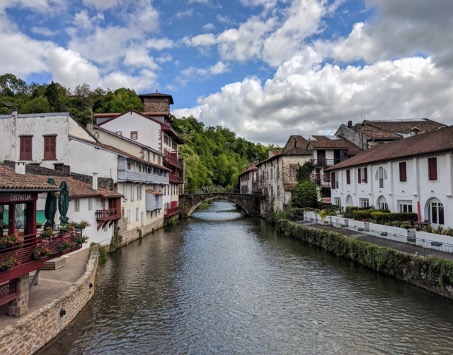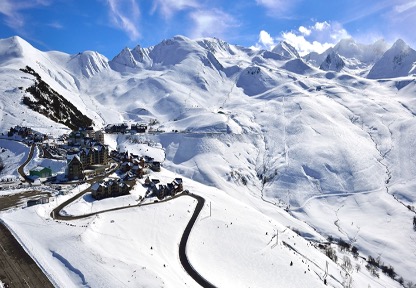Call of the Pyrénées: Incomparable mountains #2
This is the second of three articles about the mountain barrier between France and Spain. They’ll whet your appetite and get your travel juices flowing. So settle down and get yourself ready to plan your next trip to the Pyrénées.
Pyrénées: Incomparable mountains

Saint-Jean-Pied-de-Port, or St John at the foot of the pass, to Roncesvalles is considered the most difficult part of the ‘Camino Frances‘. It’s also the best-known pilgrim route across the Pyrénées.

This pretty town with steep cobbled streets and alleys has always been an important rest, recuperating, and mustering point on the Way of St James.
This is where pilgrims traditionally girded their loins and prepared to cross the mountain barrier as they embarked on the next, and most challenging, stage of their pilgrimage to Compostela.
All routes meet in St Jean, then up and up
The routes from Paris, Vezelay and Le Puy en Velay all meet in St Jean before leading on and up — and up — for another twenty-three kilometres to the thirteenth-century Abbey of Roncesvalles at the top of the pass.
Once a hospital, it is now a hostel for today’s exhausted — or exhilarated — pilgrims and hikers. A helpful and encouraging signpost points the faithful in the direction of Santiago de Compostela. It’s only 780 kilometres further on in far western Spain.

The Transhumance
The transhumance is one of the most fascinating events in the Pyrénées. Motorists, cyclists and walkers will suddenly find their road or path — large or small — blocked by a traffic jam of cattle, horses, goats or sheep — or all of the above. The herds are on the move.

Many properties in the valleys are too small to support large numbers of animals all year round. Since the Middle Ages, families of herdsmen and women have led their animals up to their summer pastures in May and June. The descent begins before the winter weather sets in, usually sometime in October. Well into the twentieth century whole families were often involved, living at the higher levels with their livestock for the warmer months. Some still sleep in small round huts or ‘orris.’ These dry-stone igloo-like constructions are built without mortar, and their roofs were covered with turf for waterproofing and insulation.
Drivers should take care. Although there’s no real danger, the animals seem to know that they have right of way. And, although the mountain people herding them are cheerful and polite, they have no concept of being in a hurry. You just have to get used to waiting for your turn to use the road — once the herd has passed on its way.
Skiing in the Pyrénées

Winter in the Pyrénées means skiing. Although the Pyrenean resorts can’t compete with their Alpine
cousins in terms of numbers or size, there’s plenty of variety here. Family favourites include La Molina
and Peyragudes. Then there’s Ax-les-Thermes with its thermal spring. And a plethora of authentic French villages, full of local skiers rather than the chic, endemic, all-tourist crowds so typical of most
Alpine resorts.
Grand Tourmalet is an off-piste paradise, and in Andorra, you’ll find the cheap and cheerful resorts of Arinsal and Pas de la Casa. Surprisingly, however, prices in the Pyrénées are generally considered very attractive, and one of the major advantages of holidaying here is that it is still relatively affordable. Ski passes, food and accommodation don’t cause the sudden jump in blood pressure they do in many Alpine resorts.
Pyrénées: Exotic flora and fauna
As one would expect, the Pyrénées support an exotic range of flora and fauna. There has been a strong revival of the almost extinct brown bear, and despite the prejudices of livestock owners and hunters, the official numbers have risen from the three that were introduced in 1996 — two females and one male — to sixty-four, including sixteen cubs last year.

If you’re hiking during the summer, and if your luck’s in, you might stumble across a ‘Saxifraga longifolia’, the magnificent ‘King’s Crown’.
Some say this spectacular plant only flowers once every hundred years.
But, although this is not quite true, it does only flower once in its life.
The Crown grows slowly on cliff faces for about five years and then suddenly sprouts a long central stalk covered in a spectacular display of small white flowers. Consider yourself lucky if you stumble across one.
Exciting Pyrénées
Whether driving, walking or riding, touring in France is always interesting. But in the Pyrénées, it’s positively exciting. Soaring mountain passes, breathtaking views, and constantly changing scenery. There’s something for everyone. Don’t miss this dramatic mountain range. Write this down on
your bucket list now: “I must visit the Pyrénées”.
Have you experienced this area of France? Share your experiences in the comments below
This 3 part mini-series ‘Call of The Pyrénées’ continues
1. Unveiling the intrigue and magic #1
2. Incomparable mountains #2 (this one)
Image credits
1-5 all commons Wikipedia
1 & 2 St Jean Pied a Port
3 Abbey of Roncesvalles
4 Ski resort at Peyragudes
5 Pyrenees flora
6 Transhumance copyright Ray Johnstone







Merci beaucoup! Very interesting articles and images! ❤️